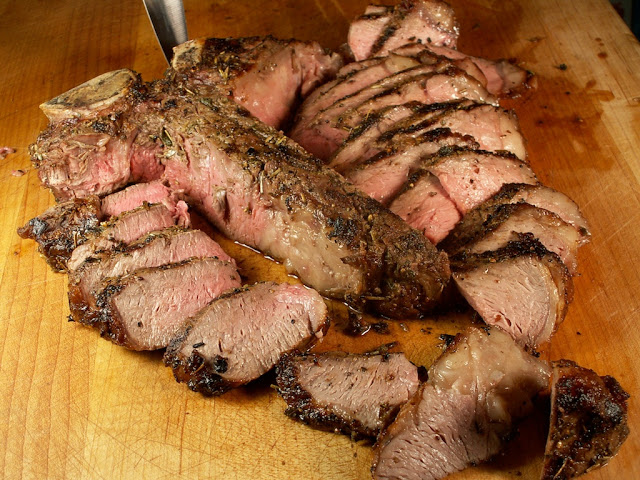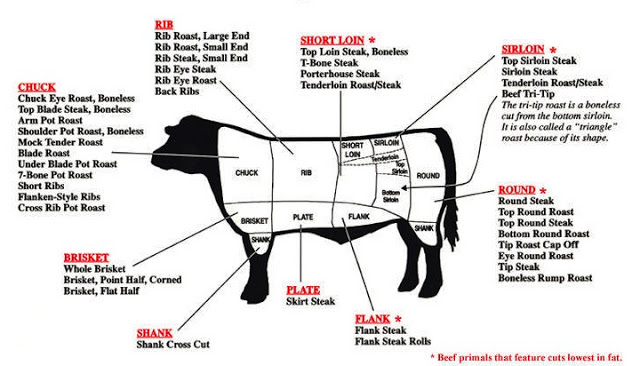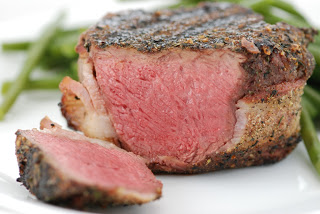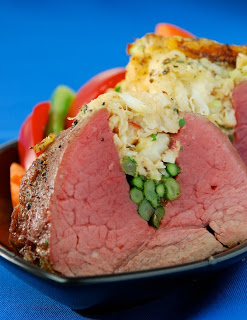With hundreds of different beef cuts, it can get confusing. Some are great on the grill, some are better oven roasts, and others need marinating or slow braising. And then there are all the crazy marketing names – what we call a NY Strip at Tony’s is also called Kansas City Strip, Top Loin Steak, Strip Steak, Shell Steak, Short Cut Steak, Club Steak, Delmonico Steak and who knows what else!
What you really need to know is how to best cook each cut regardless of local terminology or marketing mumbo jumbo – that’s where this little anatomy lesson comes in. Understanding how muscles are used makes it easy!

The T-bone Steak – the smaller side is the tenderloin and the larger side is the NY Strip. The first cut (pictured) is also known as the Porterhouse Steak.
Think about beef in three major sections:
The shoulder (Chuck), the backbone (Loin and Rib), and hind leg (Round). This week lets break down the Loin and Rib; beef’s most tender and popular cuts. I’ll cover the Chuck and Round in future stories.

The Loin and Rib
These primal cuts run along the backbone from the shoulder to the hind leg. The Loin starts at the hip and is made up of the Sirloin, the Short Loin and the Tenderloin. The Rib continues up to the shoulder. Being on the back, these muscles aren’t directly involved in walking and supporting the animals weight. Thusly these muscles don’t have to work too hard; making them among the most tender cuts. Lets break them down…

Top Sirloin on the Big Green Egg
The Sirloin
Back in the day Sirloin was often cut bone in. However, today it’s usually boned to make the Top Sirloin, the Tri Tip, and the butt portion of the Tenderloin.
The Boneless Top Sirloin
is more tender and juicy than the round, but it’s not quite as tender as the Top Loin and Tenderloin. This is because it’s on the hip and involved in walking. The Top Sirloin is a great steak, and we also fashion it into small Butcher’s Heart Roasts. Top Sirloin cubes also makes nice kabobs, and sliced into strips it’s perfect for stir-fry or quick braised in Beef Stroganoff.

The Top Sirloin benefits greatly from Extended Aging and loves marinades. It’s great grilled slowly over medium heat to about medium rare, and is one of my favorite steaks to grill. The Bone-in Sirloin Steak, click for facts and recipe
The Bottom Sirloin
is a boneless triangular-shaped cut most commonly called the Tri Tip. At about 2 LBS, it’s similar in quality to the Top Sirloin, but has it’s own special taste and texture. I feel it’s best marinated and grilled whole with low to medium indirect heat, but it can also be sliced into strips for stir-fry or stroganoff. Learn more and get recipes for Tri Tip here.
The Short Loin and Rib
Running along each side of the cow’s spine, the Short Loin and Rib sections do not have to work hard. This is where you get your T-Bone and Ribeyes teaks from.
The Short Loin
cut bone-in yields T-bone steaks, or remove the bones and you get NY Strip Steaks and the tail half of the Tenderloin. Tony’s Sicilian Smothered T-bone
The Rib

Rib Eye Steaks searing on an Infrared Grill
is where we get the Prime or Standing Rib Roast. Cut the Rib into steaks with the bone and lower grade ‘lifter’ in place for a Rib Steak, or take out the bone and remove the lifter to get a Rib Eye Steak, and a rack of ribs that are wonderfully rich and juicy.
Cuts from the Loin and Rib benefit greatly from aging, especially Dry Aging, and at their best cooked with direct medium-high heat without liquids.
Here’s a Little Known Fact:
The T-Bone, NY Strip, Tenderloin and Rib steaks all cook better when their moisture levels are the lowest possible. This is part of the reason they are so much better Dry Aged, a process which which significantly lowers water levels. For the best results, NEVER use marinades on these fine high-grade cuts, opting instead for an oil-based wet seasoning rub. Also, they’ll cook their best on an outdoor grill over medium to high heat so the juices can drip away, rather than sautéing and steaming in a skillet
.
The Tenderloin
The Beef Tenderloin is an amazing cut, but unfortunately there are only about 6 pounds on the entire animal. This muscle’s only purpose is to tilt the pelvis, which is not very often (except in bulls), so it’s the most tender cut of all.
Covered in fat and gristle, the Tenderloin is difficult to trim, so leave that to the pros. It is a slender cut about 2 feet long, thick and with three lobes on the sirloin end (the butt) and slowly tapering down to a point (the tail) near the rib.
When cutting tenderloin steaks we’ll butterfly some for larger portions and wrap them all in bacon to help keep this lean cut moist and in shape. Of course if you don’t want bacon we’re glad to oblige, the price per pound increases a little, but is about the same in total.

Tony’s Crab Stuffed Chateaubriand
As roasts we’ll tie two tenderloins together for a thicker roast and then wrap in basting fat – this makes the roast easier to cook and slice. We also do single roasts, tying the tail under for even thickness and not wrapping in fat, perfect for searing to get a nicely encrusted surface.
If trimmed correctly, there is not one part of the tenderloin that is better than another, but if you want just the perfectly shaped center cut, also known as Chateaubriand, expect to pay a premium.
So that’s it for The Loin and The Rib, feel free to ask questions in the comments below. Be sure to subscribe for follow up stories on understanding cuts from The Round and The Chuck.
Comments are closed.

